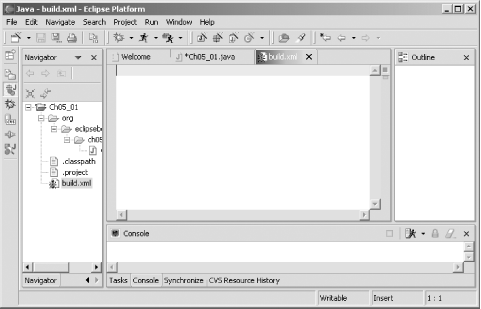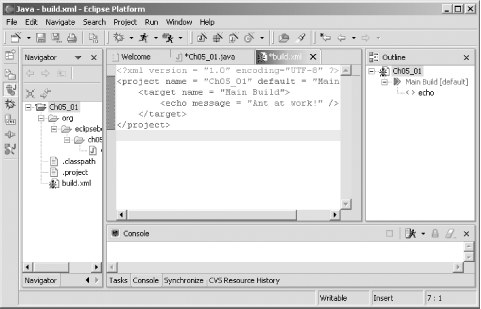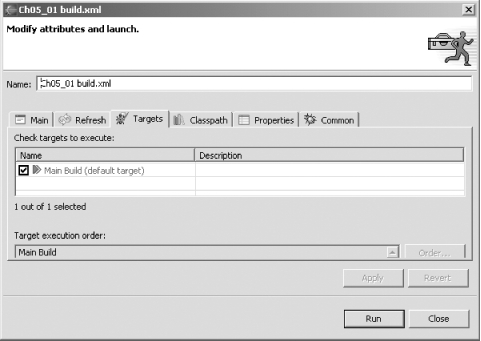|
|
< Day Day Up > |
|
5.1 Working with AntTo use Ant from Eclipse, create a new project, Ch05_01, and add a new class to it, Ch05_01. In this class's main method, we'll just display the message "No worries.", as you see in Example 5-1. Example 5-1. A sample projectpackage org.eclipsebook.ch05;
public class Ch05_01 {
public static void main(String[] args) {
System.out.println("No worries.");
}
}
To
work with Ant, we'll need an Ant build file, which
is named build.xml by default. To create that
file in this project, right-click the project and select
New Eclipse recognizes that build.xml is an Ant build file and marks it with an ant icon, as you see at left in Figure 5-1. Figure 5-1. Creating a build.xml file Enter this simple XML into build.xml—all we're going to do here is have Ant echo a message, "Ant at work!", to the console: <?xml version = "1.0" encoding="UTF-8" ?>
<project name = "Ch05_01" default = "Main Build">
<target name = "Main Build">
<echo message = "Ant at work!" />
</target>
</project>
This XML makes the target, which we've named "Main Build," into the default target. An Ant target specifies a set of tasks you want to have run, similar to a method in Java. The default target is that which is executed when no specific target is supplied to Ant. In this case, we're just going to have this default target echo a message to the console; nothing's going to be compiled. You can see this new XML in the Ant editor in Figure 5-2. The Ant editor uses syntax highlighting, just as the JDT editor does, and you can see an outline of the build.xml document in the Outline view at right. Figure 5-2. Entering XML in build.xml Save build.xml and right-click it, selecting the Run Ant item. This opens the Ch05_01 build.xml dialog you see in Figure 5-3. You can see that the default target, Main Build, is already selected. Figure 5-3. Running Ant Click the Run button in this dialog to run Ant. When you do, you'll see something like this in the Console view (note that your message was echoed here): Buildfile: D:\eclipse211\eclipse\workspace\Ch05_01\build.xml
Main Build:
[echo] Ant at work!
BUILD SUCCESSFUL
Total time: 430 milliseconds
That's exactly what we wanted this example to do. That's a quick example to show how to interact with Ant from Eclipse, but all it does is display the message "Ant at work!" It doesn't compile anything, it doesn't create any JAR files, but it does give us a start on using Ant in Eclipse. We'll get more advanced in our next example. |
|
|
< Day Day Up > |
|